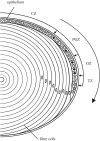A full lifespan model of vertebrate lens growth
- PMID: 28280571
- PMCID: PMC5319337
- DOI: 10.1098/rsos.160695
A full lifespan model of vertebrate lens growth
Abstract
The mathematical determinants of vertebrate organ growth have yet to be elucidated fully. Here, we utilized empirical measurements and a dynamic branching process-based model to examine the growth of a simple organ system, the mouse lens, from E14.5 until the end of life. Our stochastic model used difference equations to model immigration and emigration between zones of the lens epithelium and included some deterministic elements, such as cellular footprint area. We found that the epithelial cell cycle was shortened significantly in the embryo, facilitating the rapid growth that marks early lens development. As development progressed, epithelial cell division becomes non-uniform and four zones, each with a characteristic proliferation rate, could be discerned. Adjustment of two model parameters, proliferation rate and rate of change in cellular footprint area, was sufficient to specify all growth trajectories. Modelling suggested that the direction of cellular migration across zonal boundaries was sensitive to footprint area, a phenomenon that may isolate specific cell populations. Model runs consisted of more than 1000 iterations, in each of which the stochastic behaviour of thousands of cells was followed. Nevertheless, sequential runs were almost superimposable. This remarkable degree of precision was attributed, in part, to the presence of non-mitotic flanking regions, which constituted a path by which epithelial cells could escape the growth process. Spatial modelling suggested that clonal clusters of about 50 cells are produced during migration and that transit times lengthen significantly at later stages, findings with implications for the formation of certain types of cataract.
Keywords: branching process; lens; model; organ growth; stochastic.
Figures









Similar articles
-
A stochastic model of eye lens growth.J Theor Biol. 2015 Jul 7;376:15-31. doi: 10.1016/j.jtbi.2015.03.021. Epub 2015 Mar 27. J Theor Biol. 2015. PMID: 25816743 Free PMC article.
-
A dynamic model for the morphogenesis of the late vertebrate lens.J Theor Biol. 1997 Jun 7;186(3):349-72. doi: 10.1006/jtbi.1996.0354. J Theor Biol. 1997. PMID: 9219671
-
Temporal changes in MMP mRNA expression in the lens epithelium during anterior subcapsular cataract formation.Exp Eye Res. 2009 Feb;88(2):323-30. doi: 10.1016/j.exer.2008.08.014. Epub 2008 Sep 6. Exp Eye Res. 2009. PMID: 18809398 Free PMC article.
-
Transforming growth factor-beta-induced epithelial-mesenchymal transition in the lens: a model for cataract formation.Cells Tissues Organs. 2005;179(1-2):43-55. doi: 10.1159/000084508. Cells Tissues Organs. 2005. PMID: 15942192 Review.
-
The lens growth process.Prog Retin Eye Res. 2017 Sep;60:181-200. doi: 10.1016/j.preteyeres.2017.04.001. Epub 2017 Apr 11. Prog Retin Eye Res. 2017. PMID: 28411123 Free PMC article. Review.
Cited by
-
Age-Dependent Changes in the Water Content and Optical Power of the In Vivo Mouse Lens Revealed by Multi-Parametric MRI and Optical Modeling.Invest Ophthalmol Vis Sci. 2023 Apr 3;64(4):24. doi: 10.1167/iovs.64.4.24. Invest Ophthalmol Vis Sci. 2023. PMID: 37079314 Free PMC article.
-
Disease-related non-muscle myosin IIA D1424N rod domain mutation, but not R702C motor domain mutation, disrupts mouse ocular lens fiber cell alignment and hexagonal packing.Cytoskeleton (Hoboken). 2024 Dec;81(12):789-805. doi: 10.1002/cm.21853. Epub 2024 Mar 22. Cytoskeleton (Hoboken). 2024. PMID: 38516850
-
Whole Mount Imaging to Visualize and Quantify Peripheral Lens Structure, Cell Morphology, and Organization.J Vis Exp. 2024 Jan 19;(203):10.3791/66017. doi: 10.3791/66017. J Vis Exp. 2024. PMID: 38314859 Free PMC article.
-
Mechanism of Action of VP1-001 in cryAB(R120G)-Associated and Age-Related Cataracts.Invest Ophthalmol Vis Sci. 2019 Aug 1;60(10):3320-3331. doi: 10.1167/iovs.18-25647. Invest Ophthalmol Vis Sci. 2019. PMID: 31369034 Free PMC article.
-
Deficiency in glutathione peroxidase 4 (GPX4) results in abnormal lens development and newborn cataract.Proc Natl Acad Sci U S A. 2024 Nov 26;121(48):e2407842121. doi: 10.1073/pnas.2407842121. Epub 2024 Nov 19. Proc Natl Acad Sci U S A. 2024. PMID: 39560644 Free PMC article.
References
-
- Hariharan IK. 2015. Organ size control: lessons from Drosophila. Dev. Cell 34, 255–265. (doi:10.1016/j.devcel.2015.07.012) - DOI - PMC - PubMed
-
- Buchmann A, Alber M, Zartman JJ. 2014. Sizing it up: the mechanical feedback hypothesis of organ growth regulation. Semin. Cell Dev. Biol. 35, 73–81. (doi:10.1016/j.semcdb.2014.06.018) - DOI - PMC - PubMed
-
- Shi Y, De Maria A, Lubura S, Sikic H, Bassnett S. 2015. The penny pusher: a cellular model of lens growth. Invest. Ophthalmol. Vis. Sci. 56, 799–809. (doi:10.1167/iovs.14-16028) - DOI - PMC - PubMed
-
- Sikic H, Shi Y, Lubura S, Bassnett S. 2015. A stochastic model of eye lens growth. J. Theor. Biol. 376, 15–31. (doi:10.1016/j.jtbi.2015.03.021) - DOI - PMC - PubMed
Associated data
Grants and funding
LinkOut - more resources
Full Text Sources
Other Literature Sources
Research Materials

